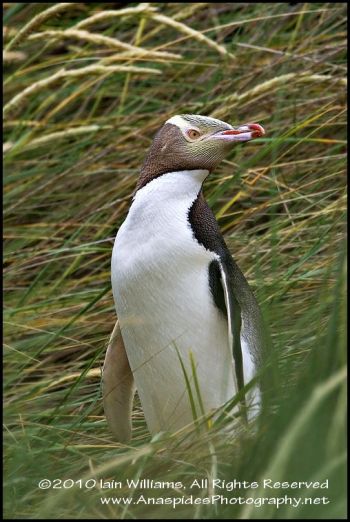 The Yellow-eyed Penguin (Megadyptes antipodes), named the “Hoihi” by the indigenous Maoris, only lives in New Zealand and is one of the rarest penguins in the world with a total population of about 4000-5000 individuals of which 1200 to 1600 are breeding. About one-quarter of these live on the east coast of the South Island of New Zealand and Stewart Island. Most of them live on Campbell and Auckland Islands, about 600 km to the south in the sub-Antarctica.
The Yellow-eyed Penguin (Megadyptes antipodes), named the “Hoihi” by the indigenous Maoris, only lives in New Zealand and is one of the rarest penguins in the world with a total population of about 4000-5000 individuals of which 1200 to 1600 are breeding. About one-quarter of these live on the east coast of the South Island of New Zealand and Stewart Island. Most of them live on Campbell and Auckland Islands, about 600 km to the south in the sub-Antarctica.
NATURAL HISTORY
The Yellow-eyed Penguin is the largest penguin found in the temperate zone and is roughly 70 centimetres in height and weighs around 5 kilograms. The penguins gain their name from the distinctive golden feathers which form a crown along their head and a bright yellow stripe that runs to the eye and around the back of the head. Non breeding individuals lack this ornamentation.
Yellow-eyed penguins spend most of the daylight hours up to 20 miles from shore feeding on opal fish, silverside, sprat, red cod, and arrow squid at depths to 400 feet. As such, they are excellent underwater swimmers and are adapted to holding their breath for up to four minutes.
LEFT: Classic image of a Yellow-eyes Penguin standing above thre dune foreshore scouting quickly for predators before turning and making its way to its nest and chick.
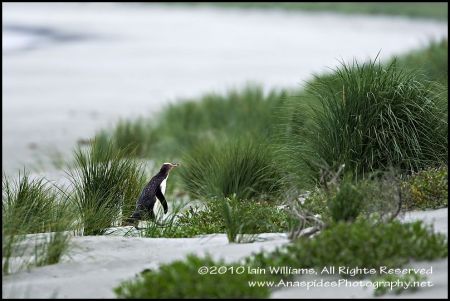 Their usual habitat is dense, cool coastal forests which afford the penguin shade during the day, shelter from the elements and protection from aerial predators. Where forest is not available (due to farming practices and land clearing in New Zealand) flax and tufted grass areas are chosen amongst sand dunes. Colonies and individual nets are scattered affairs and it’s not unknown for yellow eyes to trek up to a mile inland to their nesting site. Unlike other penguins, who in the breeding season may stay on land during the day, yellow-eyed penguins spend the day at sea feeding before coming ashore at early evening to walk to their nesting site (except in the pre egg and moulting time).
Their usual habitat is dense, cool coastal forests which afford the penguin shade during the day, shelter from the elements and protection from aerial predators. Where forest is not available (due to farming practices and land clearing in New Zealand) flax and tufted grass areas are chosen amongst sand dunes. Colonies and individual nets are scattered affairs and it’s not unknown for yellow eyes to trek up to a mile inland to their nesting site. Unlike other penguins, who in the breeding season may stay on land during the day, yellow-eyed penguins spend the day at sea feeding before coming ashore at early evening to walk to their nesting site (except in the pre egg and moulting time).
LEFT: Yellow-eyed Penguin enters foreshore vegetation on the way to its nesting site.
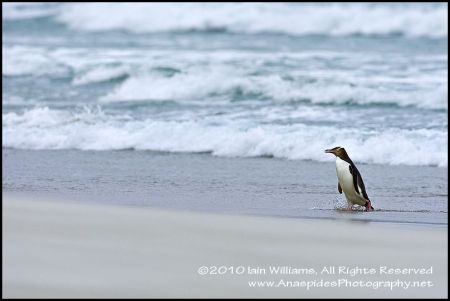 YELLOW-EYED PENGUIN CONSERVATION
YELLOW-EYED PENGUIN CONSERVATION
Because of its threatened species status, the Yellow-eyed Penguin Trust was established in 1987 to help conserve the penguin by protecting vital penguin habitat. As part of the trust’s activities, farming areas were set aside and artificial nesting containers created in the hope of increasing the numbers of penguins. Visitors to New Zealand are encouraged to visit areas that have breeding boxes established to observe and learn about the penguin. Seeing a yellow-eyed penguin in semi-controlled environment is relatively easy and areas set aside like this provide an ideal platform to educate the public in penguin conservation. However, my goal was to photograph the penguin in the wild; I particularly wanted photographs of the penguin coming ashore.
ABOVE: Yellow-eyed Penguin storms the beach after a day feeding at sea.
To assist in locating and photographing the penguins I engaged the services of a local penguin guide from Back 2 Nature Tours. Chris, the owner was a very knowledgeable and enthusiastic guide who was more than willing to try and help us photograph the penguins without disturbing them.
PHOTOGRAPHING THE PENGUINS & PENGUIN ETIQUETTE
Whenever I photograph wildlife, it’s important to understand the habits of your target animal so as to avoid causing undue stress on the animal. This is particularly important with regard to the yellow-eyed penguin as disturbance is one of the major concerns with regard to the conservation of this species.
Unlike other penguin species, the yellow eye is very highly strung and will easily jump at its own shadow! It isn’t a sociable animal and they shy well away from humans, and even prefer to nest out of sight of their own kind. This is a prime concern when photographing these penguins in the wild, for if the penguin sees you, often they will abort their shore landing.
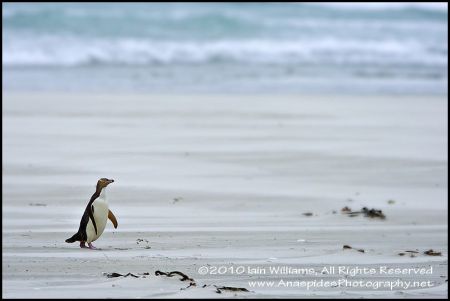 As you can imagine, photographing this penguin species is not an easy task! I soon learnt that it’s very difficult not to be seen by this penguin; their eyesight is phenomenal – getting close enough to obtain a decent photograph is tantalizingly difficult. You will need a good telephoto lens and some type of camouflage to break up your body silhouette. I spent about an hour lying in the sand waiting for the penguins to make their appearance. I’m quite sure that to a passer by I may have looked like a military sniper a target rifle!
As you can imagine, photographing this penguin species is not an easy task! I soon learnt that it’s very difficult not to be seen by this penguin; their eyesight is phenomenal – getting close enough to obtain a decent photograph is tantalizingly difficult. You will need a good telephoto lens and some type of camouflage to break up your body silhouette. I spent about an hour lying in the sand waiting for the penguins to make their appearance. I’m quite sure that to a passer by I may have looked like a military sniper a target rifle!
LEFT: Part way up the beach, a Yellow-eyed Penguin pauses to llook for potential predators.
If you don’t have a hide established, or if your walking along the beach and observe the penguins coming ashore, it’s very important that you DO NOT stand up, but lower your body as close to the ground as possible to reduce your footprint. Remember that these birds are very shy and easily scared – if you scare them and they decide not to land, then the chick will go hungry that evening. Always give the penguin right of way! If you see a penguin landing, stop, lower yourself to the ground, and wait for it to make its way to the dunes before resuming your activity.
As dusk approaches, the penguins begin to come ashore. Unlike Blue Penguins that often come ashore in rafts of 10 to 20, the yellow eye storms the beaches either signally or in pairs. Initially you will see them swimming about just past the breakers, as they scrutinise the shore searching for possible predators. If they see you, they will not land! Once they believe it’s safe, they will slowly make their way through the breakers to the beach. Once they have reached the beach, they are still very mindful of anything in their vicinity, so it’s paramount that you keep hidden and do not move about unnecessarily. Once the penguins have determined that the area is safe, they will slowly walk up the beach, into the dunes and eventually to their nests. It’s very important that you do not follow them to their nest sites as this will stress the penguin and the chick (s). Be content with watching the landing and observing the penguins as they make their way across the beach to the foreshore and dunes.
ALWAYS REMEMBER YOUR CAMERA
An odd title I know as you would think a photographer would err always have his camera with him - well not so! I was with Chris from Back to Nature Tours doing a recognisance of the area Rebecca and I were going to shot the following morning. Rebecca and I had already scaled a rather steep dune to the beach twice that day, so Rebecca opted to spend her time around the upper sections of the cliff looking about while Chris and I ran down to the beach for him to point out respective penguin access trails to me. I left my camera in the car to save the weight - BAD MOVE. As Chris and I rounded a corner on the dune, there was a yellow-eyed penguin half way up the dune. The wind was blowing and the sand was being blown about the penguin's feet. As Chris and I sat down, I wasn't that "pissed off" about not having my camera as the light was rather dull, although the penguin was close enough to get a full frame shot with a Canon 1 D MK3-S with a 70-200 lens. What did really BUG ME major time was when the clouds parted and ray of golden light struck the penguin!! I kid you not - this was the shot and where was my camera - IN THE CAR! Was I annoyed - YES. Am I still annoyed - YES. Will I do this again - NO. Message to be learnt, always carry your gear even on a recognisance outing and NEVER leave it in the car.
It was unfortunate that I only had a few days to search for the penguins. I think with a longer time period far superior images can be aquired with patience, skill, and luck!
If your interested in yellow-eyed penguins, navigate to these links for further information.
 Wednesday, August 3, 2011 at 6:07PM
Wednesday, August 3, 2011 at 6:07PM 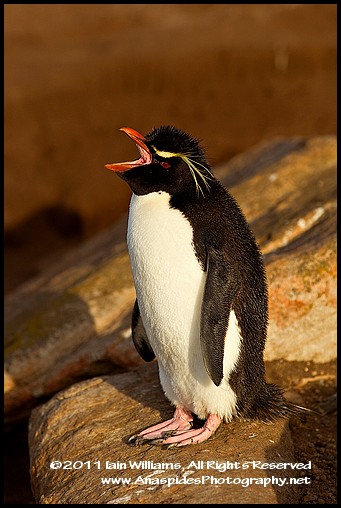 Rockhopper Penguins (Eudyptes chrysocome chrysocome) are the smallest of the crested penguins with a circumpolar distribution. They are also one of the most common penguin species in the Falklands. The penguins which weigh between 2 and 2.7 kg get their name because they move around by hopping keeping both feet together. Despite, what may seem as hindrance, they are exceptionally agile on land; I was constantly amazed by their ability to tackle the most challenging terrain as they ledge-hopped on precipitous cliff faces!
Rockhopper Penguins (Eudyptes chrysocome chrysocome) are the smallest of the crested penguins with a circumpolar distribution. They are also one of the most common penguin species in the Falklands. The penguins which weigh between 2 and 2.7 kg get their name because they move around by hopping keeping both feet together. Despite, what may seem as hindrance, they are exceptionally agile on land; I was constantly amazed by their ability to tackle the most challenging terrain as they ledge-hopped on precipitous cliff faces!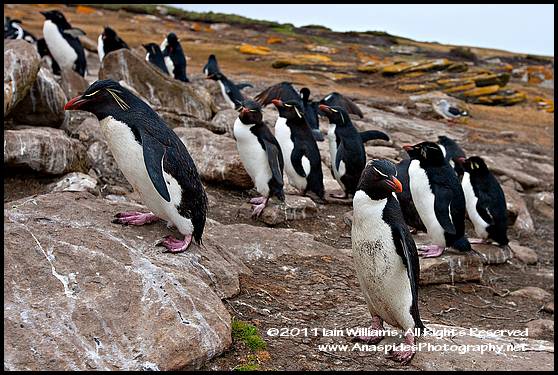 Breeding
Breeding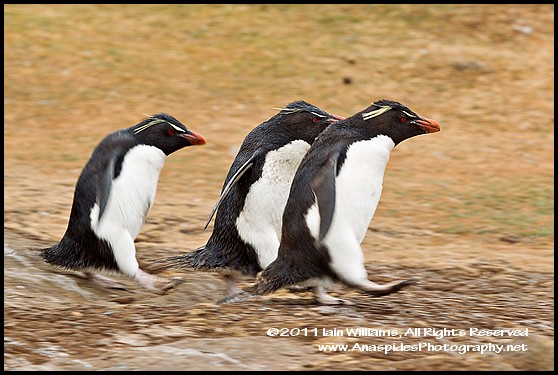 Diet and Feeding
Diet and Feeding





